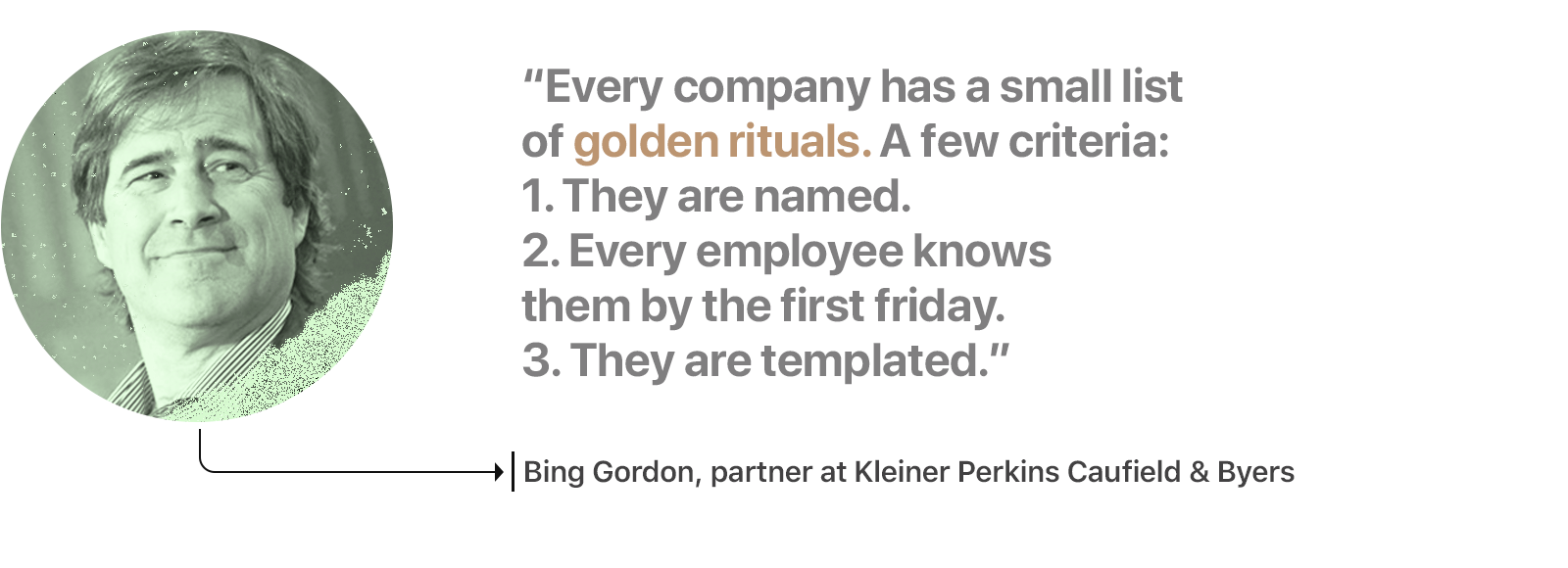Skip to content

 Why your company needs rituals: A Masters of Scale companion doc
Why your company needs rituals: A Masters of Scale companion doc
Templates and insights from on the 8/18/20 episode of Masters of Scale.
Author’s note: This interview was the spark for starting a much larger project and is being compiled into a book called . If you’d like to read more and/or participate in the book, please join the braintrust here: . In the meantime, enjoy this historical perspective!
Reid Hoffman and I recently chatted about the rituals of great teams for his Masters of Scale podcast—the episode you’re probably listening to right now. 😄 And if you haven’t had a chance yet, you can listen
and read the transcript
.As a long-time Masters of Scale listener, I’ve often found myself wanting to go a bit deeper behind an episode and really put the practices to use. So for this episode, I thought it would be helpful to write a companion guideーadditional context with a few actionable frameworks for the rituals your team does every day.
Great teams are built on great rituals.
Our episode focused on the theme of “rituals.” This generally refers to a set of common practices that a team uses, but a more precise definition may be helpful. One of my friends and close advisors, Bing Gordon, once gave me a great frame for rituals:

Bing also pointed out that these criteria lead to a limited list, so every company only has a handful of rituals—this rings true for me.
For example, for years every Googler learned about “
,” a weekly meeting where the founders answer any question from any employee. Amazon is well known for it’s . At Coda, one of our most iconic rituals is ー a pair of tools we use to run more inclusive meetings (more on this below). In each case, the rituals are often the secret sauce of how the company functions and emblematic of its truest culture.
[As a sidenote: I’m also working on a project to publish a much broader set of rituals from across teams and industries. So if you have something you’d like to share, please submit it
.] Great rituals are templatized.
Bing’s third criteria is especially important, as it signifies that core company rituals are often more than abstract concepts—they take “form.” Ask any Googler about how transparently Larry and Sergey ran Google, and rather than respond in platitudes, they will likely tell you about TGIF.
And this facet of rituals in particular fascinates me. How do you turn a value, a principle, an idea into a concrete form that can be exemplified and practiced regularly?
In many ways, this is why I co-founded Coda. I found that critical rituals for teams were created in humble documents, spreadsheets, and presentations—tools stretched and bent to capture an idea or an ethos. People reached for these horizontal tools because they needed room to flex the uniqueness of their rituals. But the real power is in a space documents and spreadsheets don’t provide, one that affirms values through engagement. From the podcast:
Reid: Creating a Word or Google doc is a ritual repeated millions of times a day across the globe. But it’s not suited to some modern problems.
So we decided to start from scratch. With Coda, we built a new doc with a dream that, as we like to say, “anyone can make docs as powerful as apps.” From the lens of forming rituals, Coda represents the tool we wish we hadーand a creative surface that we hope allows any team to create rituals of their own.
Four rituals from the podcast.
Below are a few of the rituals discussed in the podcast—some we’ve developed ourselves at Coda and some are iconic practices from teams we admire. We’ve templatized them in the hopes that you can easily adapt them for your team.
Ritual #1:
Every meeting we have is captured in a Coda doc that is separated into two parts. One is a Q&A section where everybody adds questions and votes on ones added by others. The other is a sentiment tracker that gives everyone space to express their thoughts and feelings about the meeting’s focus.
In waiting to reveal everyone’s questions and feelings, we work to remove groupthink and create a forcing function to discuss only important topics. And with the vocal minority no longer dominating the conversation, we’re able to amplify the voices of people that might otherwise be quieter. We’re a sense of accomplishment that leaves us saying, "We didn't answer every question, but we answered every question that had at least three up-votes."
Reid: Every meeting they open that document and start filling it out. Everyone knows what to do. But most importantly, everyone knows what they get out of this new ritual. Rather than drudgery of the powerpoint presentation, it brings excitement.
Ritual #2:
George Kembel, co-founder of Stanford’s d.school, believes in bringing the human element back into meetings. In addition to having a check-in similar to the sentiment tracker we use, George implements a framework for critique that he called “I like, I wish.”
George: How do you honor the human element as much as the technology and business element, and something as simple as a meeting?
When giving feedback, George has found that people tend to be overly nice, as not to hurt any feelings, which ultimately shields the truth. Or they go straight for the jugular (”This doesn’t work, and it’s stupid.”), revealing the truth in such a way that the other person can’t process it effectively. “I like, I wish” works to create a safe space where authentic, constructive feedback can be given and received.
Ritual #3:
Over the years, Coda has established a clear ritual around the water cooler—one that fosters healthy discussion and relationship building, even in a distributed environment. This ritual starts small, with the single requirement of getting people together. And while there are plenty of casual ways to encourage coworkers to engage with one another, we took a cue from process. Ultimately, our water cooler ritual ensures that people are forming a personal mutual trust that translates into assuming positive intent while at work.
Ritual #4:
One of my personal rituals began while I was at YouTube, and it’s something I still do every Sunday night in an effort to build on our company culture and identity: I write an email to the entire company.
Each email is a summary of how I feel about what happened the previous week and what I think is happening the next week. Since the email is in my own words, I fill it with my personal take on things. "This thing happened, and I thought this was great, and I really want to celebrate it. This thing didn't." Or re-contextualization of things. "Hey, we just had this major event happen. Here's what you should take away from it."
What are your rituals?
Every ritual is a look into the past and the future. They give historical context, while also pushing us to evolve.
You’ve heard me speak about our rituals—and you’ve seen them in action with this doc. Now I want to know about your team. What rituals serve as the foundation of your team? How can you keep them inclusive and empowering?
👉 Ready to get started? Head to
A few of the 25,000+ teams that 🏃♀️ on Coda.


Coda is an all-in-one doc for your team’s unique processes — the rituals that help you succeed. Teams that use Coda get rid of hundreds of documents, spreadsheets, and even bespoke apps, to work quickly and clearly in one place. This template is a Coda doc. Click around to explore.
Find out how to Coda-fy your rituals.
Want to print your doc?
This is not the way.
This is not the way.

Try clicking the ··· in the right corner or using a keyboard shortcut (
CtrlP
) instead.